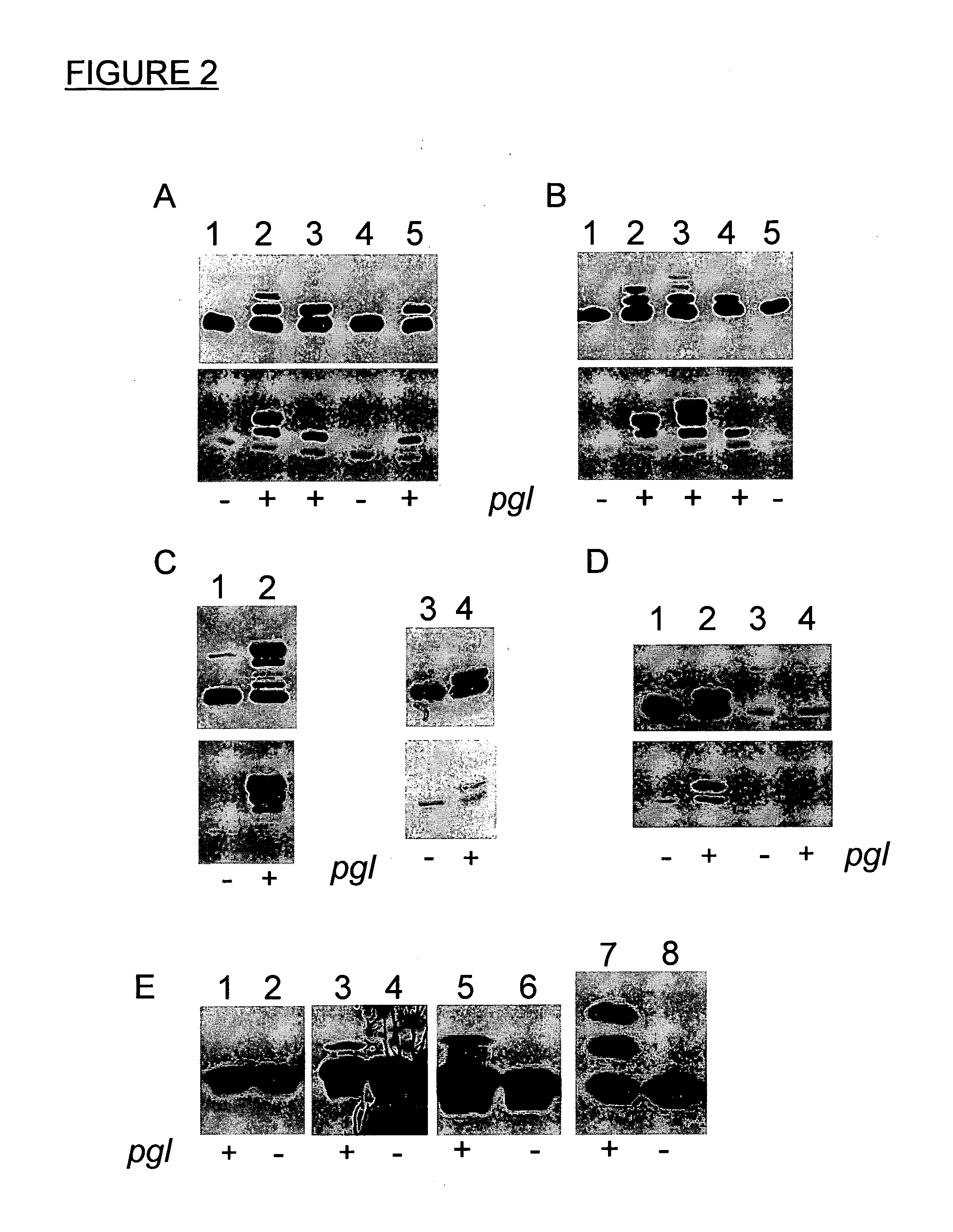Bioconjugates made from recombinant n-glycosylated proteins from procaryotic cells
a technology of procaryotic cells and n-glycosylated proteins, which is applied in the field of bioconjugates, can solve the problems of large public health risks, epidemics, and high cost of chemical conjugation, and achieves not always reliable and reproducible vaccin, and achieves the effect of reproducibility and reliable vaccin
- Summary
- Abstract
- Description
- Claims
- Application Information
AI Technical Summary
Benefits of technology
Problems solved by technology
Method used
Image
Examples
example 1
Selection of AcrA as Model Protein for Optimizing N-Glycosylation
[0172]To optimize the acceptor protein requirements for N-glycosylation detailed studies were performed on the C. jejuni glycoprotein AcrA (Cj0367c). AcrA is a periplasmic lipoprotein of 350 amino acid residues. It has been shown that secretion to the periplasm but not lipid-anchoring is a prerequisite for glycosylation (Nita-Lazar et al., 2005, supra). The signal for export can either be the native AcrA signal sequence or the heterologous PeIB signal when expressed in E. coli. Of the five potential Winked glycosylation sequons (N117, N123, N147, N273, N274) the same two ones are used in C. jejuni and E. coli (N123 and N273 (Nita-Lazar et al., 2005, supra)). AcrA was chosen as model because it is the only periplasmic N-glycoprotein of C. jejuni for which detailed structural information is available. Recently, the crystal structure of an AcrA homologue, the MexA protein from the Gram-negative bacterium P. aeruginosa, wa...
example 2
Elucidation of the Primary Peptide Sequence that Triggers Glycosylation
[0173]It is known that lipoyl domains similar to MexA of P. aeruginosa and accordingly also in AcrA of C. jejuni form a compact protein that can be individually expressed in E. coli (reviewed by Berg, A., and de Kok, A. (1997). 2-Oxo acid dehydrogenase multienzyme complexes. The central role of the lipoyl domain. Biol. Chem. 378, 617-634). To check which acceptor peptide sequence was required for N-glycosylation by the pgl machinery in E. coli the lipoyl domain of AcrA was taken. It was used as a molecular scaffold to transport peptides of different lengths to the periplasm and present them to the pgl machinery in vivo.
[0174]Therefore, a plasmid coding for the lipoyl domain (Lip) was constructed and N-terminally fused to the signal sequence of OmpA (Choi, J. H., and Lee, S. Y. (2004). Secretory and extracellular production of recombinant proteins using Escherichia coli. Appl Microbiol Biotechnol 64, 625-635) and ...
example 3
Verification of Example 2; AcrA-D121A is Not Glycosylated at N123
[0182]To confirm the findings from the peptide display approach an aspartate to alanine mutation was inserted at position 121 (D121A, i.e. 2 residues before the glycosylated N 123) in the full length soluble version of the AcrA protein and it was tested whether the site N123 could still be glycosylated in E. coli. In order to test this AcrA-D121A was expressed and its glycosylation status was analyzed. For the analysis an engineered AcrA was used. It differed from the original C. jejuni gene in that it contains the PeIB signal sequence (Choi and Lee, 2004, supra) for secretion into the periplasm and a C-terminal hexa histag for purification. It has been shown that this AcrA variant gets secreted, signal peptide-cleaved and glycosylated as the lipid anchored, native protein (Nita-Lazar et al., 2005, supra). The following is the amino acid sequence of the soluble AcrA protein:
(SEQ. ID NO. 11)MKYLLPTAAAGLLLLAAQPAMAMHMSKEE...
PUM
| Property | Measurement | Unit |
|---|---|---|
| OD | aaaaa | aaaaa |
| pH | aaaaa | aaaaa |
| pH | aaaaa | aaaaa |
Abstract
Description
Claims
Application Information
 Login to View More
Login to View More - R&D
- Intellectual Property
- Life Sciences
- Materials
- Tech Scout
- Unparalleled Data Quality
- Higher Quality Content
- 60% Fewer Hallucinations
Browse by: Latest US Patents, China's latest patents, Technical Efficacy Thesaurus, Application Domain, Technology Topic, Popular Technical Reports.
© 2025 PatSnap. All rights reserved.Legal|Privacy policy|Modern Slavery Act Transparency Statement|Sitemap|About US| Contact US: help@patsnap.com



